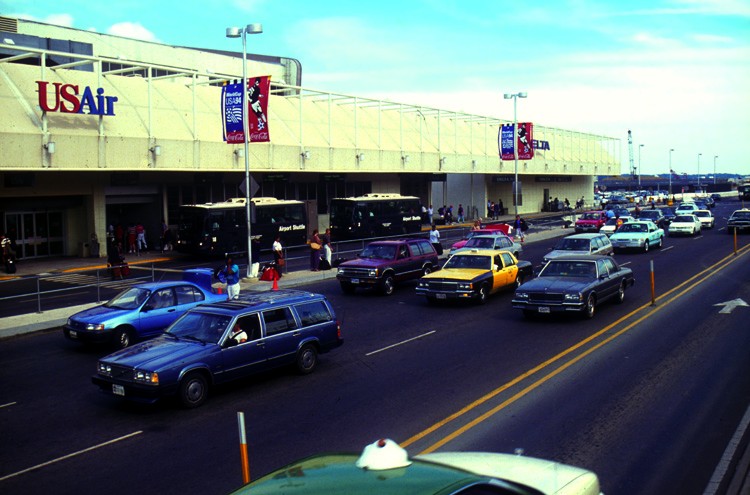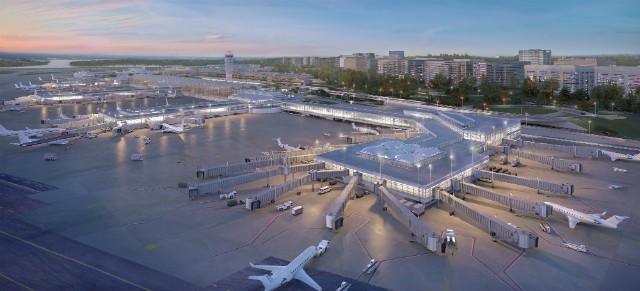Building of the Week: Hangars 11 and 12 at National Airport

Hangars 11 and 12 at Washington National airport. Image by the author.
There are two vintage aircraft hangars at the northern end of Ronald Reagan Washington National Airport that will soon give way to the airport's new commuter concourse. While many may only give them a passing glance as they bike past on the Mount Vernon Trail or board a regional flight from the dreaded gate 35X, there is more to their history, including an airline headquarters and a stint as a passenger terminal in the 1990s.
The location of hangars 11 and 12 at National airport today. Image by MWAA.
Hangars 11 and 12 are the northernmost of four hangars built on the site in the late 1940s, during the post-World War II boom in air travel. They were designed by the Federal Government's Office of the Supervising Architect, stories from The Washington Post archive show.
Allegheny Airlines, later USAir, moved in and made the hangars its main base and headquarters around the time they opened, according to the Post.
While their insides are simple open spaces, Architectural Record in 1991 described the hangars' facades as “a workaday concrete structure relieved by the merest hint of Moderne streamlining in a curved aluminum entry canopy supported by a modest pylon.”
The hangars hosted the USAir's maintenance base and its headquarters until 1988, when the airline moved to Crystal City and conversion of the structures to a temporary terminal began.
Life as a terminal
“Fasten your seatbelts, Washington. Old structures at National Airport are departing,” proclaimed an ad by the Washington Airports Task Force in the Post in July 1989. It referred to the then north and commuter terminals at National that were slated to be replaced by what is today terminal B/C.
To make that happen, though, the Metropolitan Washington Airports Authority (MWAA) had to find a way to accommodate the roughly one third of the airport's 45,000 daily passengers that passed through the buildings during construction of the new terminal.
The Interim Terminal was born. Giuliani Associates was engaged to convert hangar 11 into a 125,000 square foot terminal that could accommodate Delta Air Lines and USAir during construction, the firm's website shows.
Image by Giuliani Associates.
Keeping with historic preservation requirements, Giuliani left the integrity of the hangar interior intact with the large open space used for check in, baggage claim and ground transportation services, according to Architectural Record. A two-story addition to the east housed the post-security departure lounge and airline and airport operations functions.
A cross-section of the Interim Terminal in hangar 11. Image by Architectural Record used with permission.
The terminal opened with USAir as its sole tenant on July 1, 1989, MWAA board meeting minutes from the period show. It initially had nine gates and was later expanded to 11 to accommodate Delta, which moved in in 1991.
A USAir diagram of the Interim Terminal in 1995. Image by the author.
The Post described the Interim Terminal in 1989 as “an expansive area with a soaring, brightly lit white ceiling,” contrasting it with the “dark and cramped” North Terminal that it replaced.
The interior of hangar 11 as the Interim Terminal. Image by MWAA used with permission.
“The essential character of the [hangar] space is more tellingly defined by the airborne elements afloat within it: suspended clusters of white vinyl banners that conceal integrated accent lighting, lend the terminal focus and scale — and lift the spirit,” according to Architectural Record.
The exterior of the Interim Terminal. Image by MWAA used with permission.
The hangar continued its stint as a terminal until July 27, 1997, when the doors were closed and the then new terminal B/C opened.
“[The Interim Terminal] never held either the nostalgic charm of the old terminal or the breathless promise of the new one,” the Post reported in 1997, noting that passengers described it as a practical facility that had served its purpose during construction.
DC's mayor at the time, Marion Barry, told the newspaper at the time: “I don’t miss it. I like convenience over history.”
Making room for the future
Demolition of hangars 11 and 12 at National Airport is set to begin shortly. MWAA will build a new 14-gate commuter concourse on the site as part of its $1 billion Project Journey capital program.
The new concourse will “echo” the architecture of the Cesar Pelli-designed terminal B/C, MWAA architect Louis Lee told trade publication FlightGlobal in March. This includes yellow structural supports, “tree” columns and the building’s signature Jeffersonian domes at the end of the concourse.
Rendering of the commuter concourse that will replace hangars 11 and 12 at National airport. Image by MWAA used with permission.
While the commuter concourse will be an attractive addition to National, a small piece of the airport's history will disappear when hangars 11 and 12, and their Art Moderne streamlining, are demolished.
